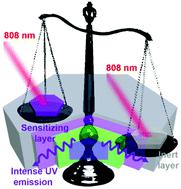当前位置:
X-MOL 学术
›
Biomater. Sci.
›
论文详情
Our official English website, www.x-mol.net, welcomes your feedback! (Note: you will need to create a separate account there.)
Balancing the thickness of sensitizing and inert layers in neodymium-sensitized tetralayer nanoconstructs for optimal ultraviolet upconversion and near-infrared cross-linked hydrogel tissue sealants.
Biomaterials Science ( IF 6.6 ) Pub Date : 2020-04-16 , DOI: 10.1039/d0bm00453g Zhongzheng Yu 1 , Yong Yao Chun , Jingwen Xue , Jodie Zu Yi Tan , Wen Kiat Chan , Weizheng Cai , Yan Zhang , Timothy Thatt Yang Tan
Biomaterials Science ( IF 6.6 ) Pub Date : 2020-04-16 , DOI: 10.1039/d0bm00453g Zhongzheng Yu 1 , Yong Yao Chun , Jingwen Xue , Jodie Zu Yi Tan , Wen Kiat Chan , Weizheng Cai , Yan Zhang , Timothy Thatt Yang Tan
Affiliation

|
Tuning the configuration of lanthanide-doped upconversion nanoparticles (UCNPs) has been proven to be an effective approach to enhance upconversion (UC) efficiency, especially for neodymium (Nd3+)-sensitized UCNPs. Rational configuration design can spatially separate activators and sensitizers, achieving the evolution from single core to multilayer structures. However, optimizing multiphoton UC emission via configuration modulation, especially in the ultraviolet range, is yet to be fully investigated. In this work, thickness tuning of the sensitizing layer containing Nd3+ ions and the inert layer containing gadolinium ions at a fixed combined thickness of 5 nm in tetralayer UCNPs to exclude the size effect is reported for the first time. The optimal thickness of sensitizing and inert layers was determined to be 3 and 2 nm respectively, showing a new strategy of balancing sensitization and surface passivation to enhance 4-photon (360 nm) emission. Although 3-photon emission (475 nm) is mainly influenced by the overall size, its emission intensity remains similar in all the tetralayer UCNPs. Additionally, an 808 nm cross-linked hydrogel has been demonstrated as a potential near-infrared activated tissue sealant. Our results have uncovered the structural parameters for optimal ultraviolet UC emissions and elucidated the strategic importance of nano-configuration design to minimize the energy loss in the high-photon UC process.
中文翻译:

平衡钕敏化四层纳米结构中敏化层和惰性层的厚度,以实现最佳的紫外线上转换和近红外交联的水凝胶组织密封剂。
事实证明,调整镧系元素掺杂的上转换纳米粒子(UCNPs)的配置是提高上转换(UC)效率的有效方法,尤其是对于钕(Nd3 +)敏化的UCNP。合理的配置设计可以在空间上分离活化剂和敏化剂,从而实现从单核到多层结构的演变。但是,如何通过配置调制来优化多光子UC发射,尤其是在紫外线范围内,尚待充分研究。在这项工作中,首次报道了在四层UCNP中以5 nm的固定组合厚度对含Nd3 +离子的敏化层和含g离子的惰性层进行厚度调节,以排除尺寸影响。敏化层和惰性层的最佳厚度分别确定为3 nm和2 nm,展示了平衡敏化和表面钝化以增强4光子(360 nm)发射的新策略。尽管3-光子发射(475 nm)主要受整体尺寸的影响,但其发射强度在所有四层UCNP中保持相似。另外,已经证明808nm的交联水凝胶是潜在的近红外活化的组织密封剂。我们的研究结果揭示了最佳紫外线UC发射的结构参数,并阐明了纳米配置设计对降低高光子UC工艺中的能量损失的战略重要性。808 nm交联水凝胶已被证明是潜在的近红外活化组织密封剂。我们的研究结果揭示了最佳紫外线UC发射的结构参数,并阐明了纳米配置设计对降低高光子UC工艺中的能量损失的战略重要性。808 nm交联水凝胶已被证明是潜在的近红外活化组织密封剂。我们的研究结果揭示了最佳紫外线UC发射的结构参数,并阐明了纳米配置设计对降低高光子UC工艺中的能量损失的战略重要性。
更新日期:2020-03-31
中文翻译:

平衡钕敏化四层纳米结构中敏化层和惰性层的厚度,以实现最佳的紫外线上转换和近红外交联的水凝胶组织密封剂。
事实证明,调整镧系元素掺杂的上转换纳米粒子(UCNPs)的配置是提高上转换(UC)效率的有效方法,尤其是对于钕(Nd3 +)敏化的UCNP。合理的配置设计可以在空间上分离活化剂和敏化剂,从而实现从单核到多层结构的演变。但是,如何通过配置调制来优化多光子UC发射,尤其是在紫外线范围内,尚待充分研究。在这项工作中,首次报道了在四层UCNP中以5 nm的固定组合厚度对含Nd3 +离子的敏化层和含g离子的惰性层进行厚度调节,以排除尺寸影响。敏化层和惰性层的最佳厚度分别确定为3 nm和2 nm,展示了平衡敏化和表面钝化以增强4光子(360 nm)发射的新策略。尽管3-光子发射(475 nm)主要受整体尺寸的影响,但其发射强度在所有四层UCNP中保持相似。另外,已经证明808nm的交联水凝胶是潜在的近红外活化的组织密封剂。我们的研究结果揭示了最佳紫外线UC发射的结构参数,并阐明了纳米配置设计对降低高光子UC工艺中的能量损失的战略重要性。808 nm交联水凝胶已被证明是潜在的近红外活化组织密封剂。我们的研究结果揭示了最佳紫外线UC发射的结构参数,并阐明了纳米配置设计对降低高光子UC工艺中的能量损失的战略重要性。808 nm交联水凝胶已被证明是潜在的近红外活化组织密封剂。我们的研究结果揭示了最佳紫外线UC发射的结构参数,并阐明了纳米配置设计对降低高光子UC工艺中的能量损失的战略重要性。



























 京公网安备 11010802027423号
京公网安备 11010802027423号